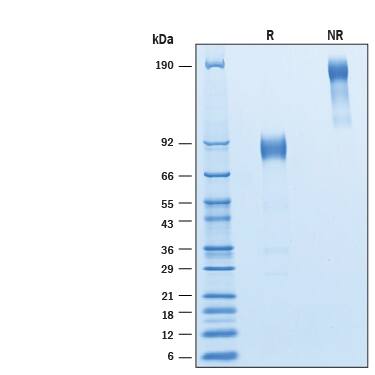Recombinant Rat CD30/TNFRSF8 Fc Chimera Protein, CF
R&D Systems, part of Bio-Techne | Catalog # 11034-CD

Key Product Details
Source
NS0
Accession #
Structure / Form
Disulfide linked homodimer
Conjugate
Unconjugated
Applications
Bioactivity
Product Specifications
Source
Mouse myeloma cell line, NS0-derived rat CD30/TNFRSF8 protein
| Rat CD30 (Phe19-Leu255) Accession # EDL81069.1 |
IEGRMDP | Mouse IgG2a (Glu98-Lys330) |
| N-terminus | C-terminus |
Purity
>95%, by SDS-PAGE visualized with Silver Staining and quantitative densitometry by Coomassie® Blue Staining.
Endotoxin Level
<0.10 EU per 1 μg of the protein by the LAL method.
N-terminal Sequence Analysis
Phe19
Predicted Molecular Mass
52 kDa
SDS-PAGE
80-95 kDa, under reducing conditions.
Activity
Measured by its binding ability in a functional ELISA.
When Recombinant Mouse CD30 Ligand/TNFSF8 (Catalog # 732-CL/CF) is immobilized at 0.250 μg/mL (100 μL/well), Recombinant Rat CD30/TNFRSF8 Mouse Fc Chimera binds with and ED50 of 20.0-120 ng/mL.
When Recombinant Mouse CD30 Ligand/TNFSF8 (Catalog # 732-CL/CF) is immobilized at 0.250 μg/mL (100 μL/well), Recombinant Rat CD30/TNFRSF8 Mouse Fc Chimera binds with and ED50 of 20.0-120 ng/mL.
Scientific Data Images for Recombinant Rat CD30/TNFRSF8 Fc Chimera Protein, CF
Recombinant Rat CD30/TNFRSF8 Mouse Fc Chimera Protein Binding Activity.
When Recombinant Mouse CD30 Ligand/TNFSF8 (732-CL) is immobilized at 0.250 μg/mL (100 μL/well), Recombinant Rat CD30/TNFRSF8 Mouse Fc Chimera Protein (Catalog # 11034-CD) binds with and ED50 of 20.0-120 ng/mL.Recombinant Rat CD30/TNFRSF8 Mouse Fc Chimera Protein SDS-PAGE.
2 μg/lane of Recombinant Rat CD30/TNFRSF8 Mouse Fc Chimera Protein (Catalog # 11034-CD) was resolved with SDS-PAGE under reducing (R) and non-reducing (NR) conditions and visualized by Coomassie® Blue staining, showing bands at 80-95 kDa and 160-190 kDa, respectively.Formulation, Preparation and Storage
11034-CD
| Formulation | Lyophilized from a 0.2 μm filtered solution in PBS. |
| Reconstitution | Reconstitute at 500 μg/mL in PBS. |
| Shipping | The product is shipped at ambient temperature. Upon receipt, store it immediately at the temperature recommended below. |
| Stability & Storage | Use a manual defrost freezer and avoid repeated freeze-thaw cycles.
|
Background: CD30/TNFRSF8
References
- Hehlgans, T. & Pfeffer, K. (2005) Immunology 115(1):1–20.
- Kennedy, M.K. et al. (2006) Immunology 118:143.
- van der Weyden, C.A. et al. (2017). Blood Cancer J. 7:e603
- Buchan, S.L. and Al-Shamkhani, A. (2012) PLoS ONE 7:e45244.
- Hamann, D. et al. (1996) J. Immunol. 156:1387.
- Shanebeck, S.D. et al. (1995) Eur. J. Immunol. 25:2147.
- Gruss, H.-J. et al. (1994) Blood 83:2045.
- Harlin, H. et al. (2002) J. Immunol. 169:2451.
- Amakawa, R. et al. (1996) Cell 84:551.
- Vinante, F. et al. (2002) Blood 99:52.
- Hargreaves, P.G. and A. Al-Shamkhani (2002) Eur. J. Immunol. 32:163.
- Oflzoglu E. et al. (2009) Adv. Exp. Med. Biol. 647:174.
Alternate Names
CD30, TNFRSF8
Gene Symbol
TNFRSF8
UniProt
Additional CD30/TNFRSF8 Products
Product Documents for Recombinant Rat CD30/TNFRSF8 Fc Chimera Protein, CF
Product Specific Notices for Recombinant Rat CD30/TNFRSF8 Fc Chimera Protein, CF
For research use only
